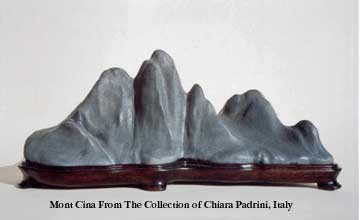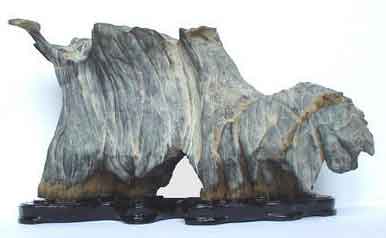
For centuries, hauntingly beautiful stones have captivated the imagination of collectors with their power to suggest a scene or object. The suggestive possibilities of suiseki are almost limitless, very much like looking at a cloud and seeing running stallions or angels, images unlimited by imagination. In the suiseki world, often heard is the term "wabi-sabi," referring to the deep spiritual understanding of /connection with a suiseki stone.
Prized suiseki are not replicas of natural objects they represent -- instead, they merely suggest the object and capture the object's essence with simple gestures; they awaken the imagination, inviting the viewer to complete the picture. They are simplicity, in accordance with Zen teachings. They are "less is more" captured in stone.
Aesthetic Qualities
| |
Suggestiveness
Subdued Color
Balance
Wabi (inward, spiritual)
Sabi (aesthetics, art)
Shibui (restrained elegance)
Yugen (sudden perception of the elusive)
|

Click to Enlarge
|

Click to Enlarge
|
Subdued Color: subtle colors arising from deep within the stone, as if illuminated by a hidden light source. The most prized suiseki are those with deep colors such as blacks, browns, greens, blues, reds.
Balance: between contrasting features:
tallness/shortness, largeness/smallness, vertical/horizontal, convexity/concavity, hardness/softness, roughness/smoothness, movement/stillness.
Wabi: a subjective feeling evoked by an object; unassuming, solitary, calm, quiet, still, impoverished or unpretentious; melancholic, lonely, desolate (classic image: abandoned fisherman's shack on a lonely beach buffeted by a strong wind on a gray wintry day)
Sabi: ancient, mature, seasoned, serene, mellowed, antique; lonely, solitary or melancholic (classic image: patina and signs of age/wear on a treasured antique)
Shibui: restrained, quiet, composed, understated, reserved, sedate; refined, elegant (classic images: a single delicate flower breaching cracks in a sidewalk; the quiet understated elegance of a formal tea ceremony)
Yugen: profound, uncertain, subtle; dark and mysterious (classic image: moon shining behind a veil of clouds, or the morning mist veiling a mountainside)
So the aesthetics of suiseki are in the small details: variations in texture and shadings of color, and nearly invisible nuances of shape. These differences distinguish an ordinary stone from a fine suiseki, where the beauty often waits for discovery, just below the surface.
Sitemap |
Search This Site
Home |
Contact Us |
Sign Our Guest Book |
Your Pages on Suiseki.com |
About Suiseki.com
All About Suiseki |
History |
Classifications |
Glossary |
Collecting |
Evaluating |
Classifying |
Preparing |
Aesthetics
Displays |
Rocks |
Bonsai & Suiseki |
Gallery |
Collectors |
Links |
Miscellaneous
© Suiseki.com ~ The Art of Stone Appreciation
P.O. Box 84, Albion, CA 95410 (707) 937-4715
E Mail:
Mike@Suiseki.com
Technical Comments:
mbouquin@mcn.org
|